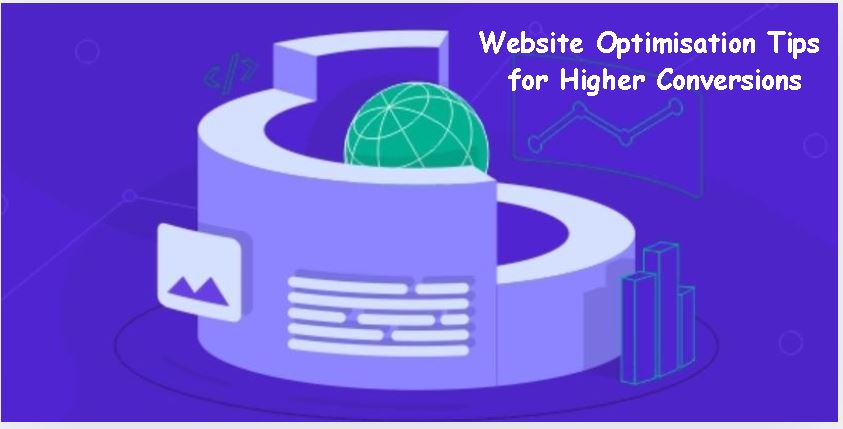Every website owner dreams of one thing—getting visitors to take action. Maybe you want them to buy a product, sign up for a newsletter, book a consultation, or download an eBook. Whatever your goal, your website must do more than look good. It must convert.
If you’ve been getting traffic but no real results, don’t worry. You’re about to learn how to transform your website into a conversion machine. This beginner-friendly article breaks down simple, practical website optimisation tips that you can apply right away, even if you’re not a tech expert.
Let’s dive in.
What Is Website Optimisation?
Website optimisation means improving your website so visitors can take action easily. It includes speed, design, content, layout, user experience, and even psychology.
Think of your website like a shop. If it’s slow, confusing, or unattractive, customers will walk out. But if it’s clean, fast, and friendly, people buy.
Your goal is simple:
Make your website easy, enjoyable, and convincing.
Now let’s explore how to do that, step by step.
1. Start With a Clear Goal for Your Website
Before you change anything, know exactly what you want visitors to do. This is the core of conversion optimisation.
Ask yourself:
- Do I want visitors to buy something?
- Do I want them to book a call?
- Do I want them to sign up?
- Do I want them to contact me?
If your website has no clear goal, visitors won’t know what you expect from them.
Tip:
Choose ONE main goal per page.
Avoid giving too many options—it confuses people.
2. Improve Your Website Loading Speed
A slow website kills conversions instantly. People leave after three seconds if a website doesn’t load. That’s how impatient users are today.
Fast websites get:
- Higher conversions
- Better user experience
- Better Google rankings
- More engagement
Easy ways to increase speed:
- Compress your images
- Use fast hosting
- Remove unnecessary plugins
- Enable browser caching
- Use a CDN (Content Delivery Network)
- Minify CSS, JavaScript, and HTML
Websites like GTmetrix and Google PageSpeed Insights can show your speed score and what needs fixing.
Remember:
Speed is the first impression your website gives. Make it fast.
3. Make Your Website Mobile-Friendly
More than 60% of users browse using mobile devices. If your website isn’t mobile-friendly, you’re losing conversions.
Mobile optimisation includes:
- Making text readable without zooming
- Ensuring buttons are big enough
- Making pages scroll smoothly
- Using clean designs
- Removing tiny clickable elements
- Keeping forms short
Google now uses mobile-first indexing, so mobile optimisation affects your SEO and conversions.
Test your site on different:
- mobile phones
- screen sizes
- browsers
If it’s hard to navigate, fix it.
4. Use Clear and Strong Calls to Action (CTAs)
A Call to Action is the button or link that tells the user what to do next.
Examples:
- Buy Now
- Get Started
- Download Free Guide
- Book a Call
- Sign Up Today
A weak CTA results in low conversions.
A strong CTA gives clarity and urgency.
Tips for better CTAs:
- Make the button stand out
- Use bright or contrasting colors
- Keep the text clear and direct
- Place CTAs multiple times on a page
- Use action verbs
- Add a benefit (“Start Free Trial”)
Your CTA should feel like the natural next step.
5. Use Simple, Clean, and User-Friendly Design
Cluttered websites confuse people.
Simple websites convert better.
Your visitors should find what they want within seconds. A confusing design causes frustration and makes users leave.
Good design includes:
- Plenty of white space
- Clear fonts
- Simple navigation
- Clean layout
- Fewer distractions
- Consistent colors
Use headings, bullet points, and short paragraphs to make content easy to scan.
Remember:
Simplicity sells.
6. Use High-Quality Images and Videos
Visual content increases trust and engagement. People process images faster than text.
But don’t overload your site with heavy media files.
Choose visuals that:
- Are relevant
- Are high quality
- Show your product clearly
- Represent your brand
- Highlight benefits
- Build emotional connection
Videos can increase conversions by demonstrating how your product works or introducing your brand.
Examples of useful videos:
- Product demo
- Customer testimonial
- Brand introduction
- How-to guide
Just ensure they load fast.
7. Improve Your Content for Clarity and Value
Your website content plays a huge role in conversions. Users want helpful, clear information that answers their questions fast.
Good website content should:
- Speak directly to the user
- Highlight benefits, not just features
- Use simple language
- Build trust
- Address user pain points
- Tell visitors what to do next
Avoid long, boring paragraphs.
Write like you’re talking to one person.
Tip:
Always answer this question for your visitor:
“Why should I choose this?”
8. Build Trust With Social Proof
People trust other people more than they trust ads. That’s why social proof increases conversions dramatically.
Types of social proof:
- Customer reviews
- Testimonials
- Case studies
- User-generated photos
- Star ratings
- Partner logos
- “As seen on” features
- Success stories
Even one testimonial increases trust.
If you have none, start collecting them now.
9. Simplify Your Forms
Forms help you collect leads, but long forms scare people away. Keep them short.
A beginner-friendly rule is:
Ask for only what you truly need.
Example:
Instead of asking for name, email, phone number, address, gender, company name…
Ask for:
- Name
That’s it.
Reducing form fields increases conversions instantly.
10. Make Navigation Simple and Intuitive
If users can’t find what they want, they leave—and never return.
Your navigation menu should be clear and simple.
Tips:
- Use descriptive menu labels
- Avoid too many menu items
- Use a clean dropdown structure
- Highlight important pages
- Keep the header simple
- Always include a search bar if you have many pages
Visitors should reach any important page within 2 or 3 clicks.
11. Optimise for SEO to Attract Quality Traffic
Traffic alone won’t convert if it’s not the right audience.
SEO helps you attract users who are already searching for what you offer.
Basic SEO optimisation includes:
- Using relevant keywords
- Writing helpful content
- Optimising meta tags
- Improving internal linking
- Creating descriptive URLs
- Using alt text for images
- Creating blogs that attract organic traffic
SEO brings long-term conversions without paying for ads.
12. Use A/B Testing to Find What Works
A/B testing helps you test two versions of a page, button, or headline to see which converts better.
You can test:
- different CTA colors
- different CTA text
- two landing page layouts
- different headlines
- images vs. videos
- long text vs. short text
Never assume—test everything.
Even small changes can double your conversion rates.
13. Add a Live Chat or Chatbot
Visitors love quick answers. A live chat feature helps you answer questions instantly, which increases conversions.
Examples of what visitors ask:
- Pricing
- Product details
- Delivery time
- Booking availability
- Help with checkout
A chatbot works 24/7 and guides people to the right product or page.
This reduces confusion and increases sales.
14. Highlight Your Unique Value Proposition (UVP)
Your unique value proposition is the reason people should choose you over others. It must be clear on your homepage or landing page.
A strong UVP says:
- what you offer
- who it’s for
- why it’s better
- what problem it solves
Examples:
- “Affordable web design for small businesses.”
- “Next-day delivery on all electronics.”
- “Organic skincare made from natural ingredients.”
Your UVP helps visitors understand your value immediately.
15. Remove Distractions From Landing Pages
Landing pages should focus on ONE goal. Avoid adding unnecessary links that pull people away.
Remove:
- sidebars
- unrelated menus
- irrelevant banners
- unrelated buttons
- unnecessary pop-ups
Your landing page should feel clean and laser-focused.
16. Use Emotional Triggers in Your Content
People buy with emotions and justify with logic. Emotional triggers help you capture attention and encourage action.
Common triggers include:
- urgency
- fear of missing out (FOMO)
- simplicity
- belonging
- trust
- desire for results
- pain relief
- curiosity
Examples:
- “Offer ends tonight.”
- “Join 10,000 satisfied customers.”
- “Get the smooth skin you deserve.”
When used correctly, emotional triggers boost conversions massively.
17. Make Your Headline Strong and Benefit-Focused
Your headline is the first thing a visitor reads.
A weak headline loses attention instantly.
A strong headline should:
- grab attention
- state a benefit
- address a need
- match the user’s search intent
Example:
Weak: “Welcome to Our Website”
Strong: “Grow Your Business With Affordable Digital Marketing Services”
The difference is clear.
One is generic.
The other sells.
18. Show Your Guarantees and Policies Clearly
People fear making the wrong decision. Guarantees make them feel safe.
Examples:
- money-back guarantee
- free trial
- free returns
- secure checkout badges
- no hidden fees
These small additions increase trust and reduce hesitation.
19. Make Your Checkout Process Smooth
If you sell products, your checkout process matters more than anything. A complicated checkout kills sales.
Make checkout:
- fast
- simple
- secure
- mobile-friendly
Reduce the number of steps and offer multiple payment options.
20. Track Your Performance With Analytics
You can’t improve what you don’t measure.
Use tools like:
- Google Analytics
- Google Search Console
- Hotjar
- Microsoft Clarity
These tools show you:
- where users drop off
- how long they stay
- which pages convert
- what devices they use
- where they click
- what they ignore
This helps you improve your conversions over time.
Conclusion
Website optimisation isn’t complicated once you understand the basics. You don’t need to be a developer or designer to improve your conversions. You just need the right strategies and a bit of consistency.
From improving speed to simplifying navigation and writing better content, these beginner-friendly tips can help you create a website that actually converts—one that works for your business, not against it.
Start small.
Test often.
Improve continuously.










